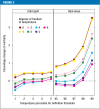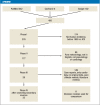The Effects of Climate Change on Patients With Chronic Lung Disease. A Systematic Literature Review
- PMID: 26900154
- PMCID: PMC4736555
- DOI: 10.3238/arztebl.2015.0878
The Effects of Climate Change on Patients With Chronic Lung Disease. A Systematic Literature Review
Abstract
Background: Ever since higher overall mortality rates due to heat stress were reported during the European heat waves of 2003 and 2006, the relation between heat waves and disease-specific events has been an object of scientific study. The effects of heat waves on the morbidity and mortality of persons with chronic lung disease remain unclear.
Methods: We conducted a systematic search using PubMed, the Cochrane Library, and Google Advanced Search to identify relevant studies published between 1990 and 2015. The reference lists of the primarily included articles were searched for further pertinent articles. All articles were selected according to the PRISMA guidelines. The heat-wave-related relative excess mortality was descriptively expressed as a mean daily rate ratio ([incidence 1]/[incidence 2]), and the cumulative excess risk (CER) was expressed in percent.
Results: 33 studies with evaluable raw data concerning the effect of heat waves on patients with chronic lung disease (chronic obstructive pulmonary disease, bronchial asthma, pulmonary arterial hypertension, and idiopathic pulmonary fibrosis) were analyzed in this review. By deriving statistics from the overall data set, we arrived at the conclusion that future heat waves will-with at least 90% probability-result in a mean daily excess mortality (expressed as a rate ratio) of at least 1.018, and-with 50% probability-in a mean daily excess mortality of at least 1.028. These figures correspond, respectively, to 1.8% and 2.8% rises in the daily risk of death.
Conclusion: Heat waves significantly increase morbidity and mortality in patients with chronic lung disease. The argument that the excess mortality during heat waves is compensated for by a decrease in mortality in the subsequent weeks/months (mortality displacement) should not be used as an excuse for delay in implementing adaptive strategies to protect lung patients from this risk to their health.
Figures




References
-
- Schuster C, Burkart K, Lakes T. Heat mortality in Berlin-Spatial variability at the neighborhood scale. Urban Climate. 2014;26:34–147.
-
- Gualdi S, Navarra A. Climate scenarios in the Mediterranean region. Forest. 2005;2:19–30.
-
- Alcamo J, Moreno J, Nováky B. Climate change 2007: impacts, adaptation and vulnerability. Contribution of working group II to the fourth assessment report of the intergovernmental panel on climate change. Cambridge University Press. 2007:541–580.
-
- Pope CA, Thun MJ, Namboodiri MM, et al. Particulate air pollution as a predictor of mortality in a prospective study of US. adults. Am J Respir Crit Care Med. 1995;151:669–674. - PubMed
-
- Dockery DW, Pope CA, Xu X, et al. An association between air pollution and mortality in six US. cities. N Engl J Med. 1993;329:1753–1759. - PubMed
Publication types
MeSH terms
LinkOut - more resources
Full Text Sources
Other Literature Sources
Medical

